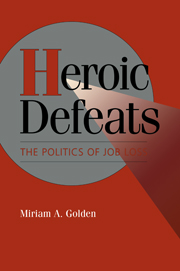Book contents
- Frontmatter
- Contents
- Preface
- List of Abbreviations
- Chapter 1 The Puzzle of Union Responses to Workforce Reductions
- Chapter 2 Games Analyzing Job Loss
- Chapter 3 Job Loss in the Italian and British Automobile Industries
- Chapter 4 Triggers of Industrial Action
- Chapter 5 Pit Closures in the Japanese and British Mining Industries
- Chapter 6 Seeking Allies: How Other Actors Affect Interactions over Job Loss
- Chapter 7 Conclusions
- Notes
- References
- Index
Chapter 5 - Pit Closures in the Japanese and British Mining Industries
Published online by Cambridge University Press: 20 January 2010
- Frontmatter
- Contents
- Preface
- List of Abbreviations
- Chapter 1 The Puzzle of Union Responses to Workforce Reductions
- Chapter 2 Games Analyzing Job Loss
- Chapter 3 Job Loss in the Italian and British Automobile Industries
- Chapter 4 Triggers of Industrial Action
- Chapter 5 Pit Closures in the Japanese and British Mining Industries
- Chapter 6 Seeking Allies: How Other Actors Affect Interactions over Job Loss
- Chapter 7 Conclusions
- Notes
- References
- Index
Summary
Perhaps more than any other industry, coal mining in the twentieth century has confronted massive job loss. To some extent, this has been an inevitable product of geology; as the coal seam becomes exhausted at a site, the pit must be closed, thereby throwing miners out of work or at least forcing them to relocate to pits still in operation. Other job loss occurred with the increasing mechanization of the industry, especially in the period since World War II, when coal was increasingly mined with less labor. But the major part of global job loss has come from the changing position of coal in world energy markets. Coal quite literally fueled the Industrial Revolution, thereafter serving as the world's principal source of energy for nearly 200 years. But sometime after the Second World War oil began to displace coal. Global employment in coal fell drastically as a result.
Because coal is traditionally mined in relatively isolated locations, the closure of pits has not infrequently confronted entire villages with the loss of their major source of male employment. The social consequences of pit closures have thus proved devastating in many instances. Rank-and-file protests, which have often been community-based, have not been unusual in a geographically isolated industry that has been in decline everywhere for nearly a half-century. These protests have often elicited widespread public sympathy; the figure of the miner, undertaking dirty and dangerous work that most people are relieved that they do not do, tends to evoke admiration and compassion.
- Type
- Chapter
- Information
- Heroic DefeatsThe Politics of Job Loss, pp. 83 - 115Publisher: Cambridge University PressPrint publication year: 1996

